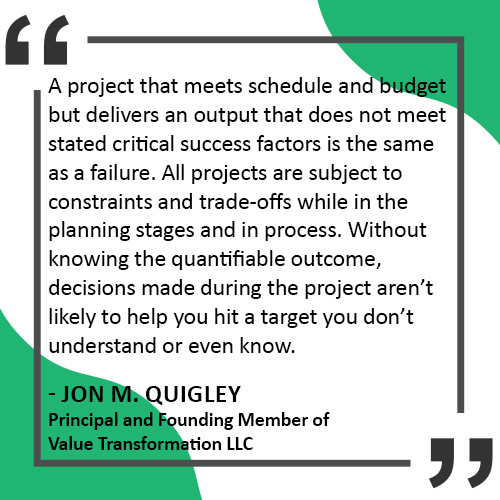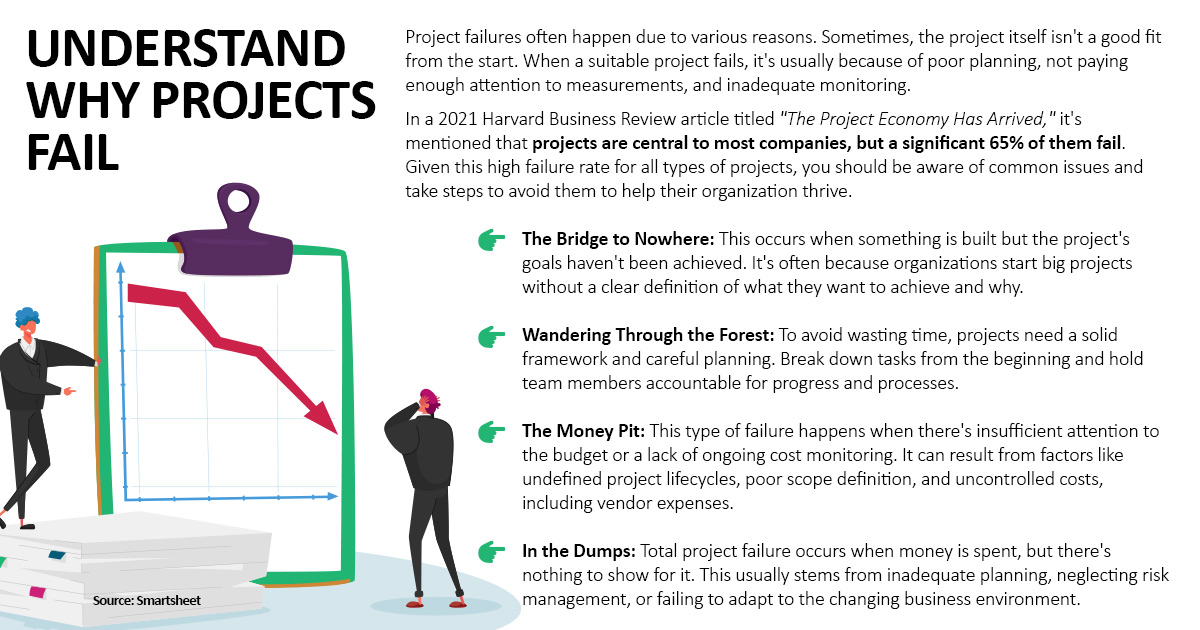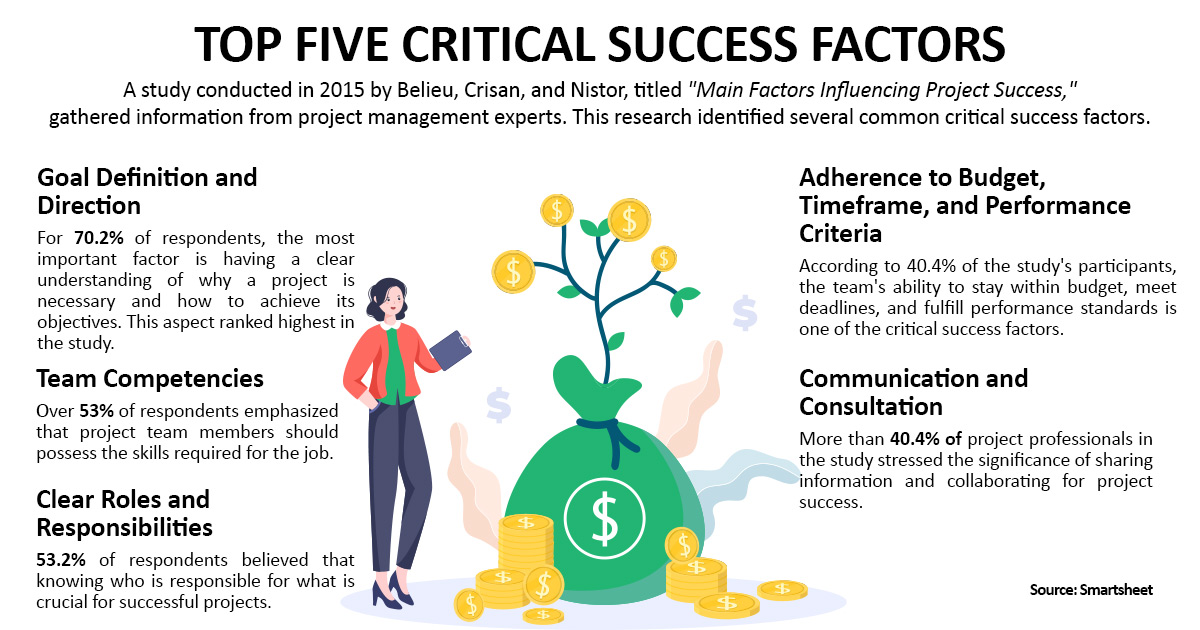
According to studies, only 34% of organizations complete projects on time or within budget. So, what separates these successful businesses from the rest? The answer lies in leveraging critical success factors (CSFs). As a project leader, it's essential to have a clear picture of what success means. Without a specific definition, it's tough to distinguish between accomplishments and setbacks and ensure that you've met your goals. If you were asked to describe the success of a particular project or business, it's common to respond in general terms. However, to truly comprehend success and extract valuable lessons from it, one must scrutinize its constituent elements. This is where critical success factors play a vital role.
They are essentially a checklist of the crucial factors your team must focus on to attain your goals. By combining these critical success factors with a strategic plan spanning three to five years, you establish a sturdy foundation for your goal-setting process. This helps you develop specific project deliverables and goals based on this solid foundation, ensuring that you achieve your goals in a timely and consistent manner.
In this article, you’ll learn why critical success factors matter to your projects, when to define CSFs, and tips to identify critical success factors. Additionally, the article discusses how modern technology solutions like artificial intelligence (AI) help you define CSFs.
What Are the Critical Success Factors in the Project Execution Process?
 Think of critical success factors as the essential building blocks for achieving the goals of an organization, business, or project. They're like the guiding principles that help you and your team decide where to direct your efforts and measure their progress toward their objectives.
Think of critical success factors as the essential building blocks for achieving the goals of an organization, business, or project. They're like the guiding principles that help you and your team decide where to direct your efforts and measure their progress toward their objectives.
Remember, critical success factors are top-level strategic objectives that do not delve into execution specifics. For example, imagine establishing critical success factors aimed at enhancing brand awareness. This ambitious objective can bring substantial value and increase your organization's market share. To make this CSF a reality, dedicated projects, and teams must work on various initiatives. Additionally, project leaders must establish measurable key performance indicators (KPIs) to provide a clear roadmap of what teams intend to accomplish and when they plan to achieve it.
To understand critical success factors better, let’s look at some examples.
Examples of Critical Success Factors
Identifying critical success factors can be challenging. The specific outcomes sought can vary significantly from one team or project to another, resulting in unique examples. However, you must remember that the CSFs you set must always align with your organization’s overall strategic goals. To give you a better idea, here are some examples of critical success factors that could apply to different situations:
- Enhancing social media engagement rates,
- Improving email open and click-through rates,
- Enhancing product features,
- Conducting performance management reviews,
- Strengthening the sales team for customer acquisition, &
- Increasing the client base monthly.
As per the various researchers, here are some critical success factors that influence a project:
- The project manager's ability to motivate the team and overcome challenges in achieving desired outcomes.
- Open and effective communication across all stakeholders is needed to ensure alignment, foster collaboration, and minimize misunderstandings.
- Maintaining a clear, controlled, and understood project scope to prevent project scope.
- Strong support and commitment from senior leadership to align the project with organizational priorities and facilitate resource allocation when needed.
- Skilled and experienced team members with expertise and motivation are essential for successful project execution.
What Is the Right Time to Define Critical Success Factors?
You should establish critical success factors during the project planning phase, along with your deliverables. Doing this together helps you see the precise steps needed to achieve your goals more clearly. A good rule of thumb is to stick to no more than five CSFs per deliverable. However, in larger projects, you might require a few more critical success factors. According to studies, 67% of projects either exceed their budgets or timelines, it's evident that many project leaders and companies don't have a full grasp of their projects' critical success factors. Having said that, too many critical success factors can make things confusing and hard to manage.
Are you wondering how to determine critical success factors for your projects? Before identifying CSFs, it is critical to understand why most projects fail. The below illustration provides an overview of common conditions that can lead to project failure.

How to Determine If Your Project Meets Critical Success Factors
Align Projects with Strategy
Derrick Hathaway, Sales Director at VEM Medical, suggests that you should use your organization's strategy as a guide to decide whether a project is a good fit or not. Ask how the project contributes to the organization's advancement, and don't hesitate to reject projects that don't align with your goals. Today, modern technology solutions, such as artificial intelligence (AI), analyze documents, emails, and communication transcripts to identify historical successes and failures, helping you brainstorm potential CSFs with stakeholders.
Seek Agreement
Bring all stakeholders, both inside and outside the organization, such as clients, sponsors, and team members, to a meeting, whether in person or virtually. Create a list of potential critical success factors together as a team, and then assess and prioritize them.
Focus on the Essentials
Take a close look at your project's individual goals and narrow down the list to the five most crucial success factors. AI automates time-consuming tasks, freeing up your human resources for higher-level tasks. This further makes it easier to keep track of and assess the most important aspects.
Identify Risks
In many projects, especially larger ones or those in regulated or highly competitive environments, managing risks is vital. This involves recognizing, evaluating, and either preventing or minimizing risks that could affect the project's desired outcomes. With the help of AI, you can analyze data to identify potential risks that could impact critical success factors and suggest mitigation strategies.
Establish Metrics
Choose the metrics to measure your critical success factors, identify ways to monitor them, and plan for what to do if you deviate from these set metrics.
So, how do you maintain transparency, assess project risks, and gain valuable insight from stakeholder feedback while assessing if your project meets critical success factors? Here, modern technology solutions, especially AI-powered predictive analytics, play a vital role. Let’s understand how predictive analytics helps you easily plan, capture, manage, and report on projects.
Predictive Intelligence for Critical Success Factors
Simply having critical success factors in your organization won't automatically make it more successful. You, the project leaders, must effectively communicate, measure, and manage these factors to carry out your strategy successfully. Predictive intelligence solutions offer centralized platforms to predict project risks while there is time to act. Additionally, you can assign tasks, keep an eye on project details, and stay in touch with your team using various solutions tailored to your project's needs. You will also have the flexibility to choose the right options for managing your project the way you prefer.
You can also track your project's progress in real-time through customizable dashboards. This simplifies sharing updates with your stakeholders during meetings and keeps everyone informed. Isn’t it fascinating?

How Do You Identify Critical Success Factors?
Once you have determined your project pain points, identified if it meets critical success factors, and integrated AI-powered predictive analytics solutions, it is time to choose critical success factors to set and track your project success criteria. Here are some crucial steps to follow:
- Start with a Strategic Plan: Create a strategic plan for your organization, outlining your goals for the next three to five years. This plan forms the foundation for your CSFs.
- Consult with Executives: Review your strategic plan with key executives and stakeholders. Identify the crucial areas, such as customer satisfaction, that are vital for your organization's success.
- Define Your Critical Success Factors: Once you've pinpointed these critical areas, establish CSFs directly linked to achieving your goals. For example, if customer satisfaction is a crucial area, a related CSF could be improving customer relationships through dedicated customer service teams. Share these CSFs with your wider team for input.
- Connect CSFs to KPIs: To make your critical success factors actionable, link them to quantifiable key performance indicators (KPIs). For example, if one of your CSFs is to enhance customer relationships through a dedicated customer service team, create KPIs like building a customer success team with at least 10 members by the end of the quarter or achieving a 12-hour customer service response time by the end of the fiscal year.
- Monitor and Measure: With your critical success factors and KPIs in place, establish a system for tracking progress and managing your organization's top-level goals. This system will help you monitor your projects and initiatives as they contribute to these overarching objectives.
The Key Takeaways
Understanding and implementing critical success factors is a fundamental component of effective project leadership and organizational success. By identifying these key strategic objectives, aligning them with your long-term strategic plan, and utilizing modern technology solutions, you can pave the way for achieving your goals with precision and transparency. Moreover, the integration of modern technology solutions, particularly artificial intelligence, further enhances the ability to monitor progress, manage risks, and make data-driven decisions.
Today, with AI-enabled predictive intelligence, you can connect your critical success factors to measurable KPIs and continuously monitor progress to adapt and thrive in an ever-evolving business landscape. It is here that TrueProject, a predictive intelligence solution for project health and performance, plays a vital role. The solution helps you get your project's current, true status and identify problems with a numerical risk score. Furthermore, TrueProject gets information from all your projects' stakeholders in one place, whether internal or external. This enables you to obtain a clear view of reality versus desired results. This way, you can ensure that every team member knows precisely what a project’s critical success factors are, understands the KPIs that will help achieve project success, and tracks the progress of each initiative.
Embracing CSFs as guiding principles empowers you to make informed decisions, mitigate risks, and ultimately steer your projects and businesses towards lasting achievements. So, remember, the journey to success begins with a well-defined roadmap of critical success factors.
More information on TrueProject at www.trueprojectinsight.com.
 About the Author
About the Author
Nivedita Gopalakrishna is a content marketing specialist within the TrueProject Marketing team with extensive experience in blog writing and website content creation across diverse industries. Nivedita’s proficiency in crafting engaging blog posts and informative website content is a testament to her years of experience. Beyond her prowess in written communication, Nivedita has a knack for creating visually appealing static graphics that have played a pivotal role in expanding TrueProject's marketing efforts. She has helped convey the brand’s essence through thoughtful design choices and captivate audiences effectively. Outside the professional sphere, Nivedita is a trained classical singer and a fitness enthusiast, embodying creativity and wellness in and out of the office.
Endnotes:
- Messineo, RJ. “How To Determine Critical Success Factors for Your Business.” ClearPoint Strategy, April 19, 2023. https://www.clearpointstrategy.com/blog/how-to-determine-critical-success-factors-for-your-business
- Yarbrough, Quincy. “What Is a Critical Success Factor? A Quick Guide.” ProjectManager, May 04, 2021. https://www.projectmanager.com/blog/critical-success-factor
- Martins, Julia. “How to use critical success factors (CSFs) to support your strategic plan.” Asana, October 11, 2022. https://asana.com/resources/critical-success-factors
- Eby, Kate. “Tips and Tools for Focusing Project Management Efforts with Critical Success Factors.” Smartsheet, February 14, 2023. https://www.smartsheet.com/content/project-success-factors
- Pandey, Shubhangi. “How to Identify Critical Success Factors in Project Management.” Project Central, January 24, 2022. https://www.projectcentral.com/blog/critical-success-factors/





